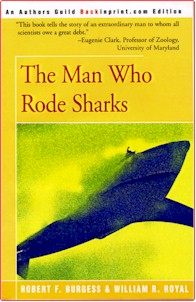|
"[This] is a must read for anyone who enjoys crackling underwater adventure!" — Florida Outdoors Magazine. Why ride sharks? Bill Royal's first large shark was wrestled in to feed his family during the Depression. Later he risked his life capturing sharks by hand, alive, for scientists doing human cancer research. One of the first pioneer cave divers, join Bill when he gets lost in an underwater cave, his light goes out, and he is taking his last breathes of air. Or go along on a 230-foot deep dive into a cave when his air runs out completely! Following a trail of prehistoric animal bones leads Royal to discover a prehistoric Ice Age Man graveyard in Florida's Warm Mineral Spring that enables scientists to recover remains dating back 12,000 years. Here is high voltage adventure about one of diving's luckiest and most fearless of its underwater pioneers. 284-pages Paperback 7x10.5x.75-inches with remarkable photographs. © 2000 Published by iUniverse.com. $17.95
TABLE OF CONTENTS:
FROM THE BOOK:
A READER REVIEW: "The Man Who Rode Sharks
was originally published in 1978 and is now republished by the Authors
Guild Backinprint Editions through iUniverse.com, Inc. This book by
Colonel William R. Royal (written with Robert F. Burgess) is about
Royal's adventures and subsequent new discoveries in shark behavior and
underwater archaeology. Actually, two stories in one, the first half of
the book details Royal's work with sharks from the 1930s through the
1960s. He became fascinated with sharks from his first encounter with
them in 1931 when he leaped into the water to catch a shark to feed his
family during the Depression Years. During his travels in the military
service he took up scuba diving and had more exciting encounters with
them in the Pacific and Mediterranean Sea. After the war Royal was
hired to capture sharks for a scientific laboratory. He became known as
'the man who rode sharks' because that is what he did to capture them
undamaged and alive. Usually he grabbed a nurse shark by the tail and
let it drag him around until it tired (always making sure he stayed
away from the head, of course). This enabled his catch to be loaded
aboard a boat alive, a requirement requested by scientists doing
research on squalene, a shark liver extract being investigated then as
a possible cure for human cancer. The second half of the book is about
Royal's most important contribution to science. When he moved to
Florida in 1958, he became interested in Warm Mineral Springs and
Little Salt Springs in the central part of the state. Up to this point
no one had ventured very deep into these springs. Shortly after scuba
gear became available in this country, Royal donned this equipment and
started exploring these over 200-feet-deep springs. What he found there
proved too unbelievable for the scientists of the day. Deep in Warm
Mineral Spring beside prehistoric animal bones buried in mud on a
forty-foot deep ledge, Royal found a human skull that carbon-dated to
over 10,000 years old! And inside it was identifiable human brain
material! Stalactites from the ceiling in the underwater spring
indicated that this was once a dry cave, believed to date back to the
last Ice Age. Since Early man was not thought to have been in Florida
then, scientists of the day questioned the authenticity of these finds,
especially since they had been made by an 'amateur.' Royal spent much
of his life trying to persuade qualified underwater archaeologists to
come to the spring and do a proper archaeological investigation of the
sites. Eventually they did and toward the end of his life, the
scientific community properly recognized the pioneering part Bill Royal
played in these discoveries. Written in a narrative style by Robert
Burgess, who dived these sites with Royal to photograph and record
details of his achievements, he details Royal's incredible narrow
escapes from sharks, cave-ins and dangerous depths. His style enables
readers to relive the excitement of these adventures of a truly unique
underwater pioneer. Anyone who thrives on fast-paced true adventure
action will find this book a real hair-raiser!" © 2000, 2001 Robert F. Burgess. All rights reserved. |
 THE MAN WHO RODE
SHARKS
THE MAN WHO RODE
SHARKS
